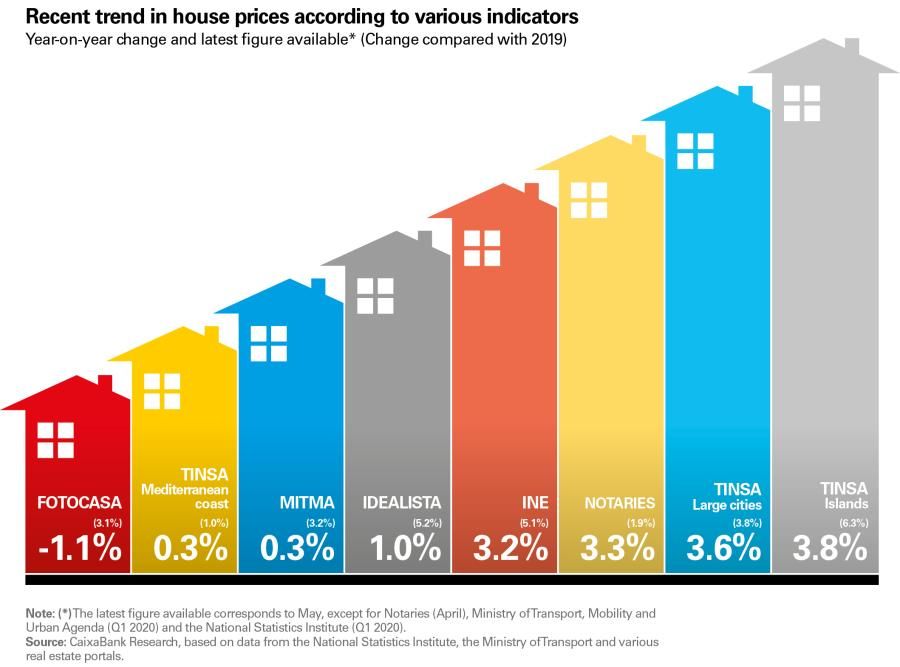House prices will be affected by the crisis but with notable differences depending on the geographical location and type of property
Given the dramatic decline in demand, house prices are likely to undergo some adjustment in the period 2020-2021, although there will be significant differences depending on the property's location and type. Specifically, we expect house prices to fall more sharply in the second-hand market and tourist areas, which have been severely affected by the restrictions on international travel.

House prices were already slowing down before the COVID-19 shock
According to data published by the Ministry of Transport, Mobility and Urban Agenda (based on valuations), house prices fell by 0.8% quarter-on-quarter in Q1 2020. In year-on-year terms, progress was still positive with a slight increase of 0.3%, albeit a marked slowdown compared with the 2.1% year-on-year growth recorded in Q4 2019. The house price data published by the National Statistics Institute (based on transaction prices) also posted a slowdown to 3.2% year-on-year in Q1 2020 compared with an increase of 3.6% in Q4 2020. This deceleration was caused by lower growth in the price of second-hand housing (0.4% quarter-on-quarter), while new builds recorded a significant rise (5.1% quarter-on-quarter).
House price indicators from different real estate portals (based on the sale prices on offer), which are published more frequently and with less time lag, are gradually starting to reflect the impact of the crisis. For example, the Fotocasa index, which reflects the trend in the price per square metre of second-hand housing, fell by 1.1% year-on-year in May, while the Tinsa index showed a tiny increase on the Mediterranean coast (0.3%). However, significant growth is still being recorded in large cities (3.6%) and the Balearic and Canary Islands (3.8%), although in both cases a slowdown can be observed compared with the growth posted in 2019. Lower prices are also starting to be seen in apartments offered for sale on real estate portals, although the impact on transaction prices is still small, for the time being.

In the second half of the year, the negative trend in house prices is expected to increase
In the second half of the year, the negative trend in house prices is expected to increase. Typically, after a significant drop in sales, prices tend to adjust a few months later. On this occasion the decline in sales has been very sharp due to the lockdown measures restricting people's mobility. It is therefore to be expected that house prices will gradually react to the new environment.
There is considerable uncertainty regarding the extent of the adjustment in house prices during this recession. We believe it very unlikely that prices will adjust as much as they did during the previous recessionary period and the price adjustment period is also likely to be significantly shorter. As already mentioned in the previous article, the real estate sector is not the cause of the current shock nor has it accumulated imbalances that would require price adjustment mechanisms to be implemented to regulate and control the system. In particular, real estate was not overpriced in general before COVID-19.1 All this has led us to produce scenarios in which the adjustment in house prices will be more contained than in the last crisis. Specifically, we predict that house prices could fall by between 6% and 9% during the 2020-2021 period in Spain as a whole. While house prices would start to show positive growth rates in the second half of 2021, we do not expect them to return to the pre-crisis level before 2024.
- 1See the article «The widening gap between Spain's house prices» available at: https://www.caixabankresearch.com/en/sector-analysis/real-estate/widening-gap-between-spains-house-prices.
In 2020-2021, house prices will adjust to some extent,
this correction being larger in tourist areas and for second-hand housing.
The trend in price will vary greatly depending on the location of the property
Those markets that already had more price tension, such as the centre of big cities and tourist areas, will see a bigger adjustment. The size of the adjustment will partly depend on how investor interest in these areas evolves because, in recent years, such investments have contributed to the increased dynamism of these markets.2 Changes in residential preferences in terms of where and how to live, encouraged by, for instance, the greater prevalence of working from home in the «new normal», may reduce pressure on residential prices in the most congested cities and shift some of the demand to conurbations with the best connections to workplaces.
On the other hand, the house price trend in tourist areas will be highly dependent on the recovery in international travel. Although restrictions were partially lifted at the end of June, the recovery in tourist flows is expected to be incomplete as long as there is no vaccine or effective treatment against the disease.
- 2See Álvarez, L, Blanco, R. and García-Posada, M. (2020), «La inversión extranjera en el mercado inmobiliario residencial español entre 2007 y 2019», Boletín Económico del Banco de España 2/2020.

There may also be significant differences in price trends by housing type
The decline in house prices is likely to be greater in the second-hand market, which accounts for the bulk of transactions (over 80% in 2019), since this is usually more sensitive to the economic cycle. The decline in the price of new housing will be smaller as supply is more limited in this segment. This dichotomy in the evolution of the price of new and used housing was also observed in the previous recession: from its peak in 2008 to its lowest point in 2013, the price of new housing fell by 32% in cumulative terms while second-hand housing saw a much bigger cumulative drop of 43.7%. Moreover, this pattern was observed in all the autonomous regions.
